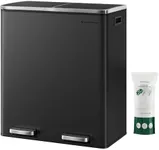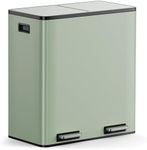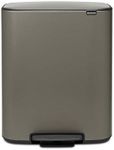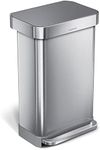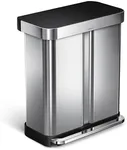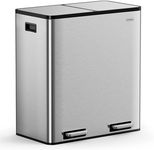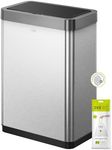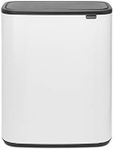Buying Guide for the Best Kitchen Bins
Choosing the right kitchen bin is essential for maintaining cleanliness and organization in your kitchen. The right bin will not only fit your space but also accommodate your waste disposal needs efficiently. When selecting a kitchen bin, consider factors such as size, material, type, and additional features that can enhance convenience and hygiene. Understanding these key specifications will help you make an informed decision that suits your lifestyle and kitchen setup.SizeThe size of a kitchen bin is crucial as it determines how much waste it can hold before needing to be emptied. Bins come in various sizes, typically measured in liters. Small bins (up to 20 liters) are suitable for single-person households or small kitchens, while medium bins (20-40 liters) are ideal for small families. Large bins (over 40 liters) are best for larger families or those who generate a lot of waste. Consider your household size and how often you want to empty the bin when choosing the right size.
MaterialKitchen bins are commonly made from plastic, stainless steel, or a combination of materials. Plastic bins are lightweight and affordable, making them easy to move and clean. Stainless steel bins are more durable and often have a sleek, modern look, but they can be heavier and more expensive. Some bins have a combination of materials, offering a balance between durability and cost. Choose a material that fits your kitchen's aesthetic and your preference for durability and maintenance.
TypeThere are several types of kitchen bins, including pedal bins, touch bins, and sensor bins. Pedal bins open with a foot pedal, keeping your hands free and reducing contact with the bin. Touch bins open with a light touch, which can be convenient but may require more frequent cleaning. Sensor bins open automatically when they detect motion, offering the highest level of convenience and hygiene. Consider how you prefer to interact with your bin and the level of convenience you desire when selecting a type.
CompartmentsSome kitchen bins come with multiple compartments for sorting different types of waste, such as recyclables and general waste. This feature is important if you want to separate waste at the source, making recycling easier and more efficient. Bins with two or more compartments are ideal for environmentally conscious households or those with limited space for separate recycling bins. Consider your recycling habits and space availability when deciding if a multi-compartment bin is right for you.
Lid MechanismThe lid mechanism of a kitchen bin affects how easy it is to use and how well it contains odors. Some bins have a soft-close lid that reduces noise and prevents slamming, while others have a tight-sealing lid to keep odors contained. A bin with a removable lid can be easier to clean and empty. Consider how important odor control and ease of use are to you when choosing a lid mechanism.
Additional FeaturesAdditional features such as built-in deodorizing systems, bag holders, or wheels can enhance the functionality of a kitchen bin. Deodorizing systems help control odors, while bag holders keep liners in place and make changing bags easier. Wheels can make it easier to move the bin around, especially if it's large or heavy. Think about which features would make your waste disposal process more convenient and choose a bin that offers those enhancements.



